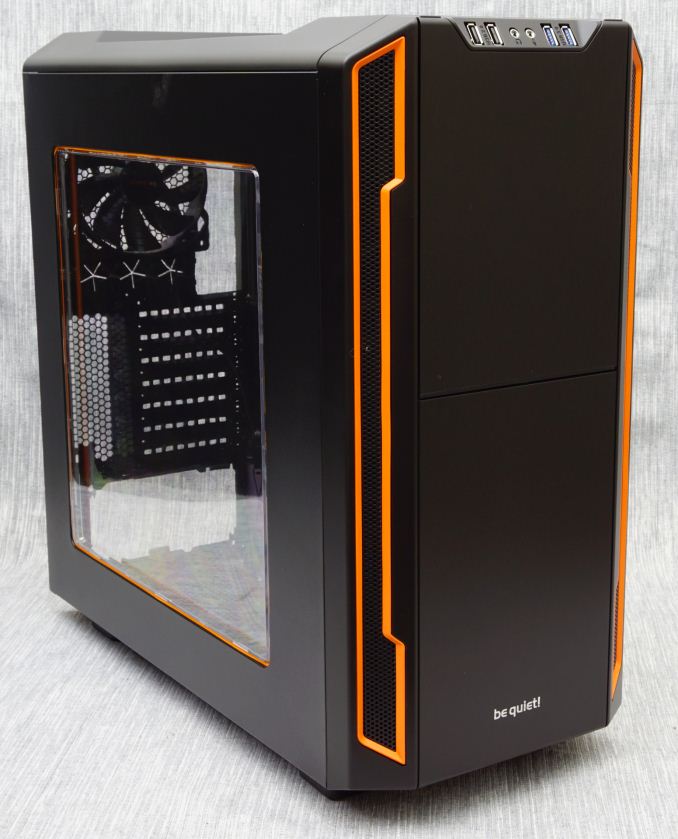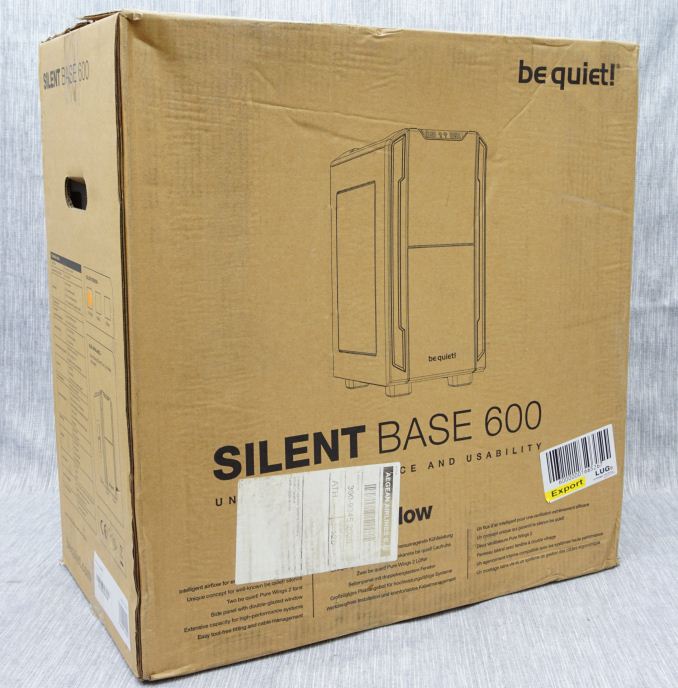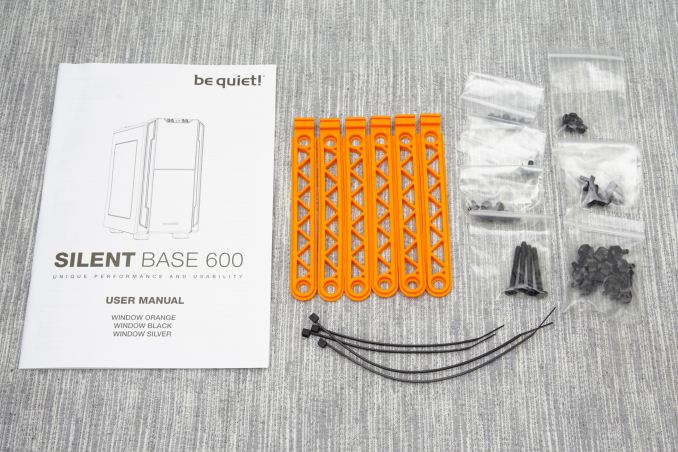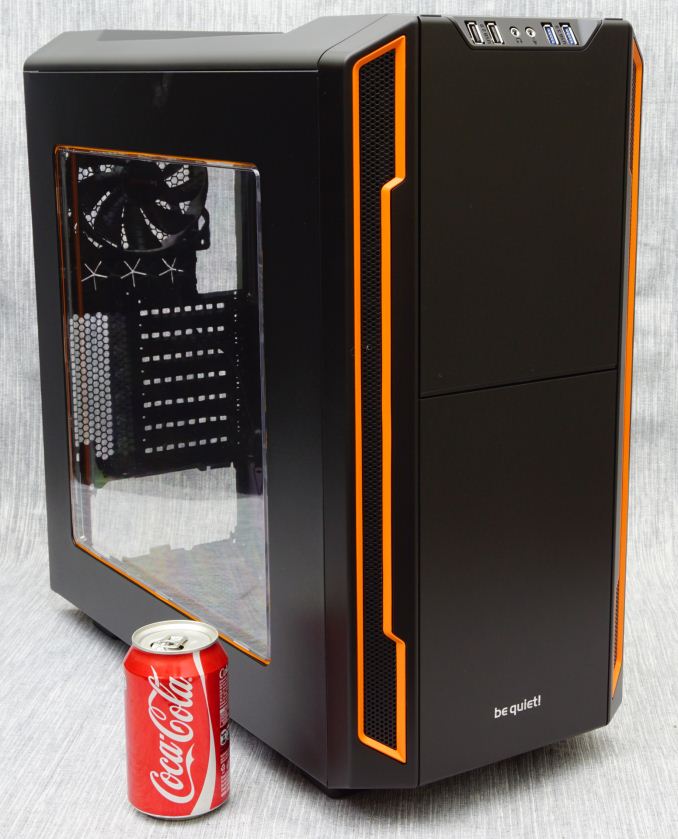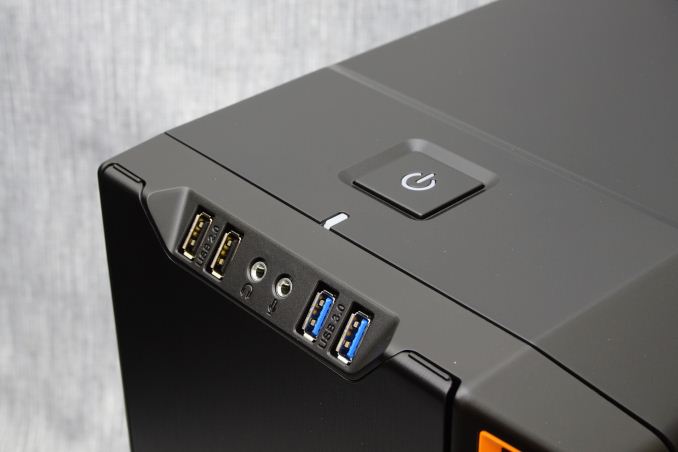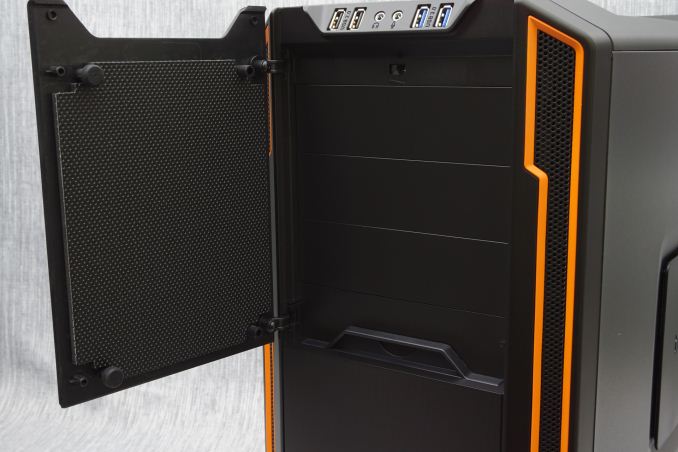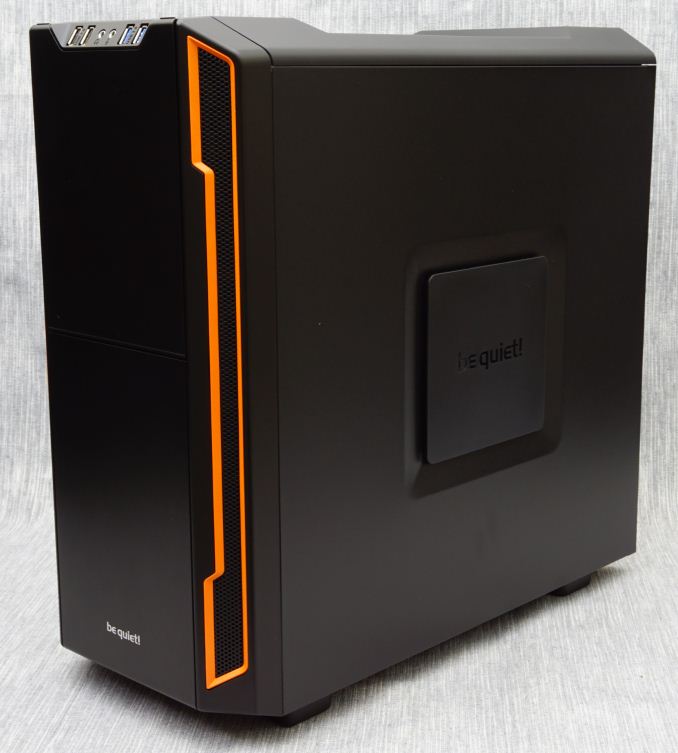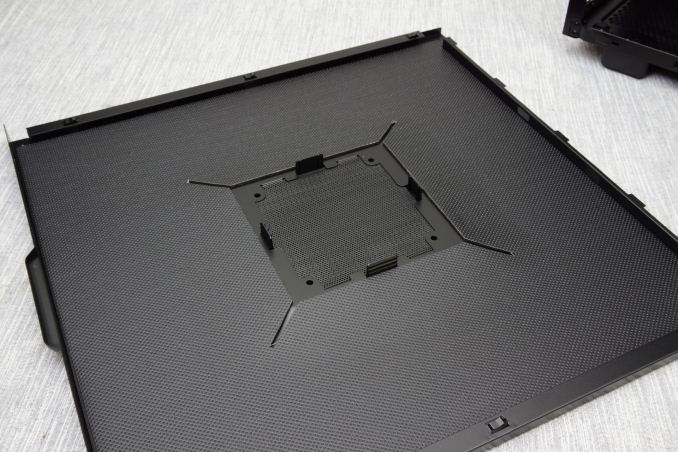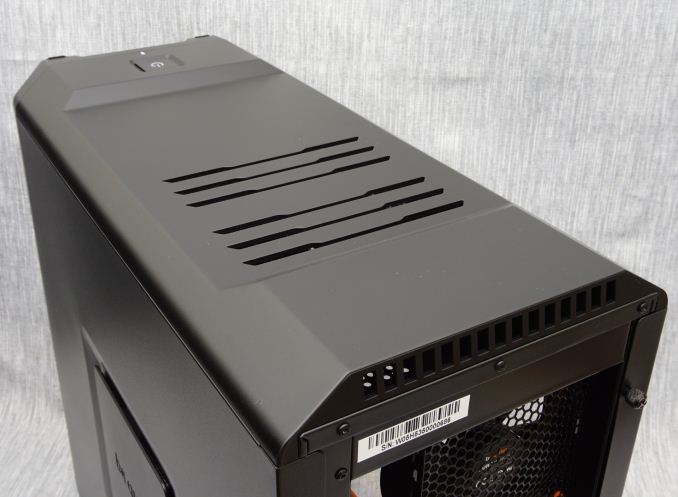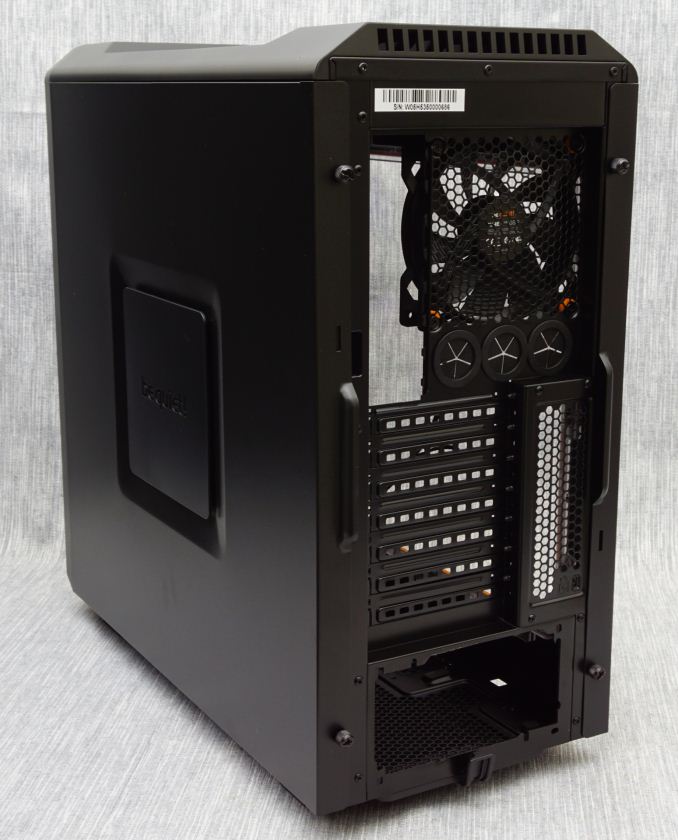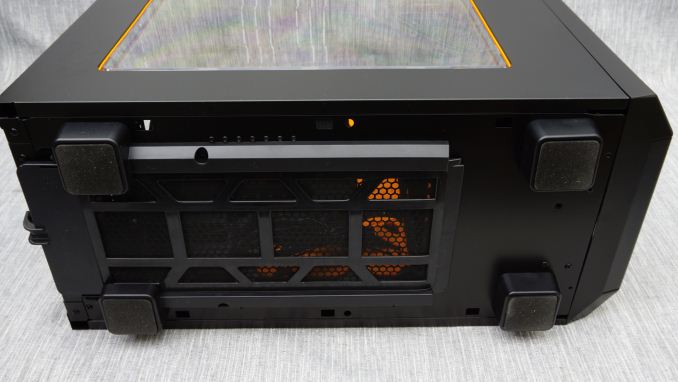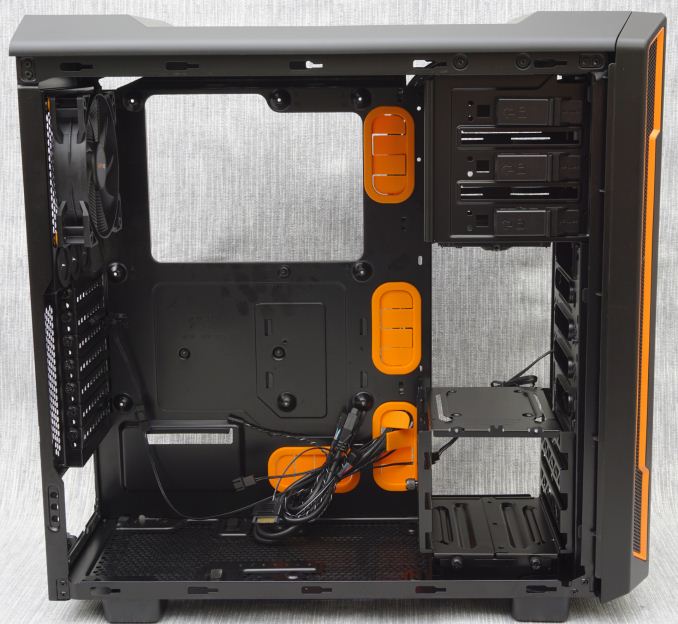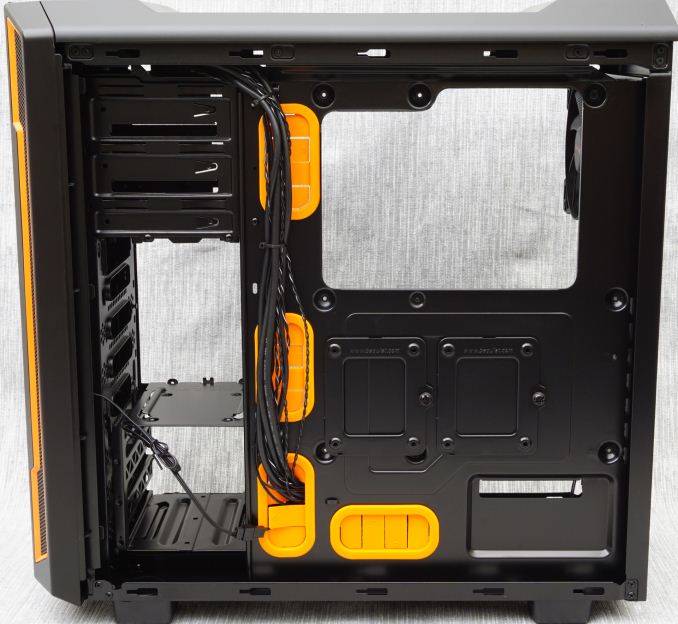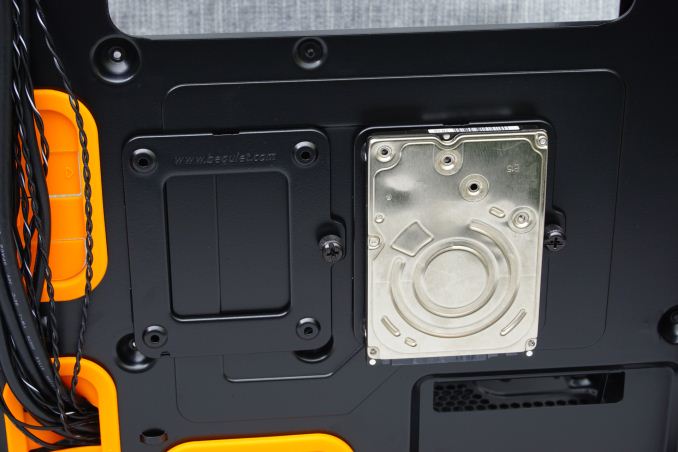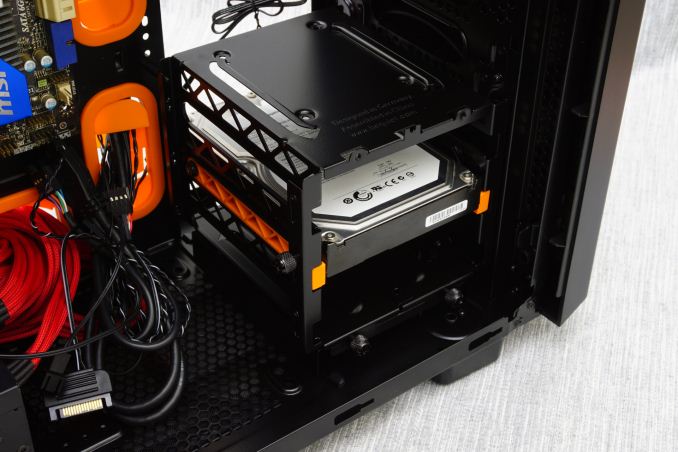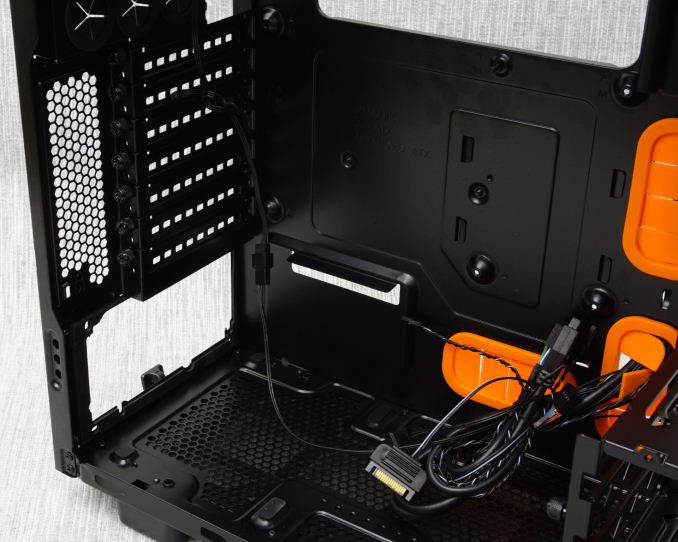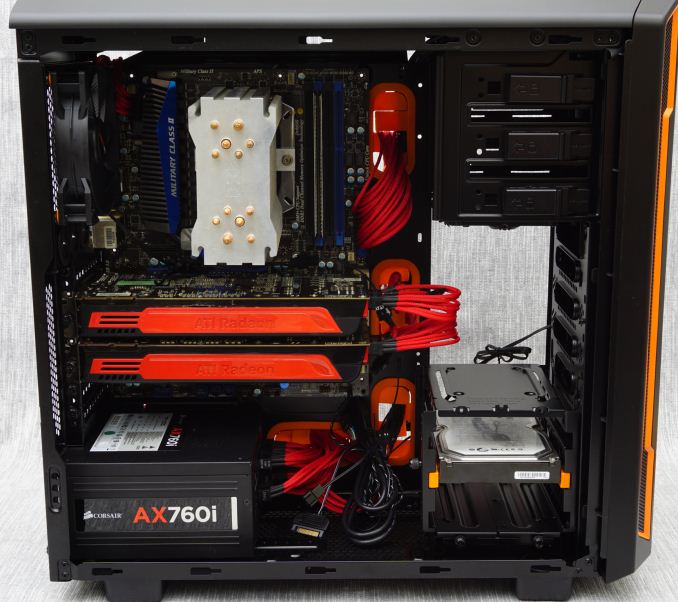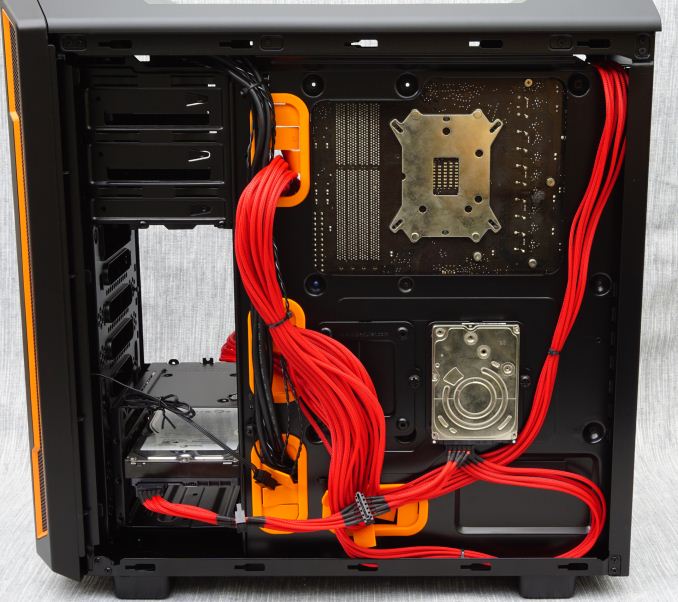
Original Link: https://www.anandtech.com/show/10837/the-be-quiet-silent-base-600-atx-case-review
The Be Quiet! Silent Base 600 ATX Case Review
by E. Fylladitakis on November 17, 2016 9:00 AM EST- Posted in
- Cases/Cooling/PSUs
- be quiet!
- ATX
- Case
- Silent Base 600
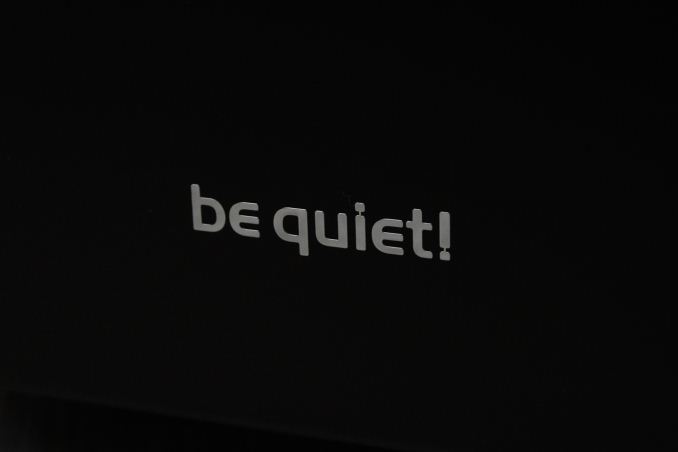
Be Quiet! might not be a widely known brand name in North America, but the German company is highly popular as a manufacturer of low-noise PC components in Europe. The company has been shyly making its way into the North American market and several of their products can now be found via North American e-tailers and retailers.
Introduction
As a company focused on providing low-noise solutions, Be Quiet! primarily became popular from producing and marketing fans, coolers and power supply units. Not so long ago however the company also diversified into one more segment of the market, that of PC cases. They currently have two different cases, the Silent Base 600 and the Silent Base 800, with each of them available in six variants.
It is their more popular and cost effective Silent Base 600 that we are going to have a closer look at this review. The Silent Base 600 is an ATX case of typical proportions, designed to provide good overall performance and flexibility combined with sound-dampening features. It is available in six different versions but they are all practically identical, with the end user having to choose between three faceplate trim colors (black, orange or silver) and a windowed or solid left side panel. The sample that we received for the means of this review is the orange color variant with the windowed side panel.
| Be Quiet! Silent Base 600 | ||
| Motherboard Size | ATX, Micro-ATX, Mini-ITX | |
| Drive Bays | External | 3 × 5.25" |
| Internal | 3 × 3.5" (Front drives cage) 2 × 2.5" (Behind the motherboard tray) 1 × 2.5" (Front drives cage) |
|
| Cooling | Front | 2 x 140 mm (one included) |
| Rear | 1 × 120 mm (included) | |
| Top | 2 × 120 mm / 140 mm (optional) | |
| Side | 1 × 120 mm (optional, solid panel version only) | |
| Bottom | 1 × 120 mm / 140 mm (optional) | |
| Radiator Support | Front | Up to 120 mm or 240 mm |
| Rear | Up to 120 mm | |
| Top | Up to 240 mm | |
| Side | - | |
| Bottom | - | |
| I/O Port | 2× USB 3.0, 2× USB 2.0, 1× Headphone, 1× Mic | |
| Power Supply Size | ATX | |
| Clearances | HSF | 167 mm |
| PSU | 160/290 mm (with/without a bottom fan) | |
| GPU | 295/410 mm (with/without a drive's cage) | |
| Dimensions | 495 mm × 230 mm × 493 mm 19.49 in × 9.06 in × 19.41 in |
|
| Prominent Features | · Simple mounting and tool-free fitting of drives · Air intake filters that are easily accessed for cleaning · Space for water cooling radiators · Two pre-installed Pure Wings 2 fans feature nine airflow-optimized fan blades and are decoupled from the case to circulate air with a minimum of vibration · Side panel with adjustable vent that can be closed for silent operation, partially open for increased air intake or open with an additional fan for higher cooling performance · Cable management is supported with space for organizing cables, silicone rubber grommets, and pass-throughs |
|
| Price | $127 | |
Packaging & Bundle
Be Quiet! Supplies the Silent Base 600 in a simple brown cardboard box. The artwork is monochromic and based on a simple schematic of the case itself. The box however is sturdy and the case inside it is well protected between thick Styrofoam slabs, providing excellent shipping protection.
The company kept the bundled items down to a minimum. Along with the case we received only the necessary mounting hardware and screws, the required silicone rails for the installation of 3.5" devices, just four cable ties and a very undetailed manual that could have been more detailed.
The Exterior of the Be Quiet! Silent Base 600
Be Quiet! tried to aesthetically balance the Silent Base 600, with the simple geometric shapes forming an understated, yet modern design. It is an all-black case with a colored trim surrounding the front intake air vents and the windowed side panel. The Silent Base 600 is available with its trim colored orange, black or silver; we received the orange version for this review. The matte black paint is very smooth and flawlessly applied, with an excellent feel to the touch, but its treated surface is like a sponge for fingermarks.
The proportions of the Silent Base 600 are normal for an advanced ATX case, with the exception of the extended width to allow for the support of more advanced cooling options. It measures 49.5 cm tall, 23.5 cm wide and 48.2 cm deep (19.5 × 9.25 × 19.4 in), which results to a volume of 57.3 liters. It shared almost the same volume as the BitFenix Pandora ATX and the Corsair Carbide 600Q (57.8 and 57.1 liters respectively), yet its width makes it significantly larger than a basic ATX case such as the Zalman Z9 Neo (48.4 liters).
11.2 oz soda can inserted as a size reference
Be Quiet! placed the front I/O ports at the top of the faceplate, on a roughly 30° angle, making it very convenient for the user to access them if the case is placed on or near the floor. There are two USB 2.0 ports, two USB 3.0 ports and the standard 3.5mm headphone jacks. The system's power on button is found at the top of the case and is a large, square button with an illuminated power logo. A small LED near the front of the case displays the HDD activity. There is no reset buton.
The magnetic faceplate door opens from right to left, revealing a black plastic fascia with three 5.25” drive slots. A thick layer of sound absorbing material is installed to the inside of the door. The front air intake filter is very conveniently accessible from here, removable by simply pulling it upwards. A close inspection above the 5.25" bays reveals a very small three-way switch, which is used as a basic but effective fan speed controller.
This is one of the few cases with a fan slot on the right side panel. The elegant square decorative plastic cover at the center of the right panel can be adjusted to allow for the installation of a 120 mm intake or exhaust fan. A simple metallic mesh dust filter is preinstalled into the slot. However, the installation of even a thin 120 mm fan on the right side of the case offers virtually no practical advantage and will cause several clearance issues. Even though it is possible to install a fan on the right side panel, the company does not recommend it. The design of the right side panel simply is identical to that of the left side panel of the non-windowed version of the case. Thick sound-dampening material is installed on the right side panel.
The vents at the top cover are very narrow, most likely designed so as to reduce the direct transfer of sound waves from the interior of the case, dampening the noise of the system. The user however needs to be careful with the selection of the fans, as very high airflow fans will cause the narrow openings to generate aerodynamic noise, negating any positive effects from this design.
A look at the rear of the Be Quiet! Silent Base 600 hints a lot about it design. The PSU compartment is found at the bottom of the case, vents are formed next to the expansion card covers and on the covers themselves, with a 120 mm exhaust fan right above them. The core concept of the design obviously is to draw air in as silently as possible via indirect openings at the front of the case and use positive pressure to force the air out of the rear of the case. The three round openings with the rubber grommets also hint that there is no room for very large liquid cooling systems inside the system area, but the designer thoughtfully offered the option to install an external liquid-based cooling system.
The Silent Base 600 stands on four very tall, square plastic feet with rubber anti-slip pads installed. These tall feet improve the bottom air intake of the case from the (optional) fan and the PSU. A nylon filter can be seen covering the PSU intake, which can be removed from the back of the case.
The Interior of the Be Quiet! Silent Base 600
The interior of the Silent Base 600 is sprayed with the same matte black paint as the exterior, making it also highly prone to fingermarks. However, the grommets that cover the cable management holes are colored depending on the version of the case. Since we received the orange version of the Silent Base 600, the grommets are orange. They are also made of quality silicone, making them significantly more durable than most such grommets that we have seen to this date.
A very wide opening on the motherboard tray allows for the installation of aftermarket CPU coolers without having to remove the motherboard from the case. In an effort to maximize compatibility, Be Quiet! extended the opening to the rightmost boundaries of an ATX motherboard, meaning that it will not be fully covered if, for example, a Flex ATX or Mini ITX motherboard is installed. Expanding the opening so far to the right side of the motherboard is strange for a case that does not support Extended ATX motherboards, as it is extremely unlikely that the CPU socket of an ATX motherboard will ever be placed so far to the right.
Four large openings for the cables covered by silicone grommets are present along the right side and the bottom of the motherboard. There are also small openings above the motherboard that are not covered by anything. These openings are very small due to the little clearance between the motherboard and the top of the case, with the EPS CPU power connector barely able to fit.
For cooling, Be Quiet! has two of their Pure Wings fans installed, one 140 mm at the front and one 120 mm at the rear of the case. They are both installed using decoupling silicone grommets to minimize noise and are attached to the case's fan controller. Even at their maximum speed these two fans can only go up to 900 RPM and 1200 RPM respectively, which is usually barely enough to reach audible noise levels.
Two small metallic trays can be found at the backside of the motherboard's tray. These trays are held in place with thumbscrews and each of them can hold one 2.5" drive. For reasons unknown, Be Quiet! engraved their website's URL on them. There is little else of interest on the back of the motherboard tray, with even the cable tie points limited to just a couple near the cable openings. The company is using simple cable ties to hold the cables, there are no cable ties installed and only very narrow cable ties would fit under the small tie points.
One front drive cage is installed in the Silent Base 600 by default, with room for one more. Assuming that it is convenient, the single drive cage can be installed beneath the 5.25" drives as well, leaving the lower front of the case unobstructed. It supports the installation of up to three 3.5" drives and one 2.5" drive. Be Quiet! devised the installation of 3.5" using silicone rails that effectively decouple the drive from the chassis, minimizing the transfer of vibrations and, therefore, noise. The 2.5" is secured using simple screws.
At this point, it is reasonable to assume that many of our readers would be worried about the longevity of the silicone rails, as their destruction would mean that no 3.5" drives can be installed. Silicone is virtually inert and does not react chemically with most substances, including anything that is present in typical atmospheric air. Even the lowest quality silicone has a lifetime in room temperature that is measured in decades. There is a good reason why silicone is the material of choice for cosmetic and medical body implants.
The PSU compartment is uncovered, with the PSU sitting on rubber cushions. The entire area beneath of the PSU is perforated, ensuring that the PSU's fan will draw air in easily, despite the PSU's length and the exact position of its intake fan. A metal support brace on top of the PSU helps keeping it in place, but these types of supports can very easily scratch the paint off a PSU, requiring extra care during the assembly of the system.
For the means of this review, we installed a Corsair AX760i with the red cable set, for strong visual contrast. The AX760i fits inside the Be Quiet! Silent Base 600 comfortably, revealing however that extra-long PSUs will partially block the bottom cable management hole. There is very little clearance between the PSU and the motherboard. The case is designed to have all of the PSU cables moving along the side of the motherboard, which can be a little tough when the PSU's cables are thick or too many cables are needed, but the large 21.5 mm clearance behind the motherboard's tray helps. The routing of the CPU EPS cable can be a small problem, as the 2.5" trays block it. In our case, the cable of our AX760i was barely long enough to reach the motherboard's header.
A standard ATX system fits well inside the system area of the Silent Base 600. Very long cards can be installed if there is no second 3.5" drive tray, but the routing of the cables will have to be done via the open area in front of the main system area. For a case this wide, the compatibility with CPU coolers up to 167 mm tall is not great, but it should suffice for the majority of the advanced air coolers currently available. Due to the little clearance between the motherboard and the top of the case only very few all-in-one liquid coolers with very narrow radiators will fit, and even then there might be compatibility problems. The design does offer the possibility to install a large external liquid cooler by placing holes at the rear of the case, but we feel that would beat the primary purpose of the Silent Base 600, which is to acoustically insulate the system installed in it.
Test setup
Professional testing requires the emulation of real-world situations but with repeatable results; thus, a perfectly controllable test setup and environment are required, especially for comparable results. Testing the thermal performance of any case with a typical real-world setup technically limits the comparability of the results to this setup alone, as an active system interacts with its environment and the change of a single component would alter myriads of variables. As such, we developed synthetic loads that emulate the thermal output of real systems, which however are passive, steady and quantifiable. As such, the thermal testing now displays the thermal capabilities of the case alone, as if it would have to deal with the entire thermal load by itself, regardless of the system that would be installed inside it. Laboratory data loggers are being used to monitor the PT100 sensors and control the safety relays, which are fully accessible via our custom software. Three such loads have been developed; the ATX version simulates a 200W CPU, 50W VRM, 30W RAM and 4 × 120W GPU card thermal load. Finally, three 3.5" HDD dummy loads have also been created, with each of them converting 30 W of electrical power to thermal, bringing the total thermal load of the ATX test setup up to 850 Watts. As such, the thermal load is immense and only the best of cases will be able to handle it for more than a few minutes, we are also performing a test with a thermal load of 400W, with all of the aforementioned components except the HDD drives at about 42% power, which is more suitable for the majority of cases.
Thermal testing has been performed with all of the case's stock fan operating at maximum speed. Noise testing has been performed with a background noise level of 30.4dB(A). Advanced noise testing is also being performed, in order to assess the ability of the case to dampen the noise of the components installed inside it. This includes the installation of two noise-generating sources (strong fans) inside the case, one positioned approximately over the first expansion slot and one over the CPU area, which generate ≈ 44.2 dB(A) when unobstructed. During the advanced noise test, all stock cooling options of the case are entirely disabled.
Results and discussion
Although the stock thermal performance of the Be Quiet! Silent Base 600 is acceptable, it is definitely not going to break any records. With the primary focus of the designer being to deliver a cost-effective product that can effectively insulate the system's noise, the thermal performance took a significant hit. The installation of insulative material further reduced the heat transfer potential of the case and the stock cooling fans were meant to be quiet, not powerful.
In summary, the thermal performance of the Silent Base 600 is about equal to that of the In Win 303; a case with no stock cooling fans at all. It falls behind nearly ever equally sized case that we have tested to this date, with the sole exception of the low-cost BitFenix Neos, a case that failed to complete our tests but costs less than half as much as the Silent Base 600.
As expected, the stock cooling fans of the Silent Base 600 are borderline audible when they are running at their maximum speed. Only a very low tone, aerodynamic humming noise emanated from the case when the stock fans are running at their maximum speed. Reducing the speed of the fans virtually kills their noise output.
The overall design of the Silent Base 600 and the installation of sound dampening material at the panels of the case may have a negative impact on its thermal performance, but the noise insulation is excellent. The Silent Base 600 reduced the noise output of our dummy testing system by 5.7 dB(A), one of the highest figures that we have ever seen. Note that this is the version with the acrylic left side panel; the version with the insulated panel should improve noise insulation, even if only marginally.
Conclusion
Be Quiet! designed the Silent Base 600 to be a high quality, cost-effective case focused on low-noise operation. In terms of quality, the materials used are very good and the overall build is durable enough for a typical ATX tower case. The core chassis however seems to be more of a retrofitted old design rather than a modern case, with low clearances and few usability features. Modern gaming systems, especially those designed with low-noise operation in mind, often make use of liquid cooling solutions in order to achieve acceptable thermal performance levels. The Silent Base 600 is incompatible with a very large percentage of the currently available all-in-one coolers, as well as being incompatible with very tall air coolers. The designer did install holes for the use of large external liquid coolers, but such a cooler defeats the core purpose of the Silent Base 600 by transferring a major noise source outside of the case.
Even though the core design of the chassis seems is what it is, the design does deliver excellent noise insulation as promised. The Silent Base 600 has excellent sound-dampening capabilities and the stock cooling fans are barely audible even at their maximum speed. With its stock cooling fans down at their minimum speed and a quality low-noise CPU cooler, the Silent Base 600 should be more than capable of providing seamless and completely silent operation with a medium-power CPU and GPU installed. For advanced gaming systems, especially multi-GPU systems or systems with significantly overclocked components, the cooling system of the Silent Base 600 should definitely be upgraded. The installation of more fans or loud components in the Silent Base 600 will certainly make the overall system audible, yet the acoustic insulation of the case will in any case dampen that noise, resulting to comparatively better acoustic performance. In extreme circumstances, where the inability of installing large coolers/radiators becomes an important factor and forces the user to compensate with additional airflow, the noise output of the Silent Base 600 can match or even exceed that of more spacious cases with greatly superior thermal performance.
In summary, we discovered that the Be Quiet! Silent Base 600 practically is a remodeled older chassis that is heavily balanced towards low-noise operation. The thermal performance of the Silent Base 600 leaves much to be desired, but the acoustic performance is truly exceptional. However, in North America Be Quiet! is fighting an uphill battle against the competition when it comes to value. The Silent Base 600 is the first case that we have seen to this date that is more expensive in the US rather than in the EU, and it already is expensive in the EU. With a retail price of $127 at the time of this review, the Silent Base 600 is going to face very steep competition, as much more advanced cases are available near this price point.

